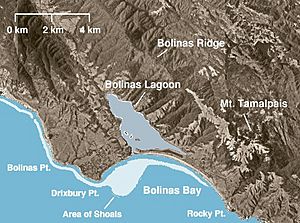Duxbury Reef State Marine Conservation Area facts for kids
The Duxbury Reef State Marine Conservation Area (SMCA) is like a special underwater park. It's located about 2 kilometers (1 mile) west of a town called Bolinas in Marin County, along California’s central coast. This protected area covers about 1.7 square kilometers (0.66 square miles) of ocean. In this special area, most sea creatures are protected. You can't take them out of the water. However, people are allowed to fish for finfish from the shore and gather abalone for fun.
Contents
History of Duxbury Reef's Protection
The Duxbury Reef SMCA became a protected area in August 2009. It was part of a bigger plan called the Marine Life Protection Act Initiative. This plan aimed to create a network of protected ocean areas all along California's coastline.
Many different people worked together to design these protected areas. Local divers, fishermen, scientists, and people who care about nature helped create the plan. Their goal was to protect sensitive sea life and their homes. They also wanted to make sure people could still enjoy the ocean for fun, learning, and study.
The new marine protected areas along California's north central coast officially started on May 1, 2010.
Geography and Natural Features
Duxbury Reef SMCA is located near Bolinas in Marin County. Duxbury Reef itself is one of the largest shale reefs in North America. A shale reef is a large, flat area of rock made from hardened mud. This reef is found north of San Francisco’s famous Golden Gate Bridge. It is also within the Point Reyes National Seashore, a beautiful coastal park.
The Duxbury Reef SMCA includes the area from the high tide line out into the ocean. It stretches about 300 meters (1000 feet) from the lowest low tide mark. The boundaries of the area are set by specific points in the ocean.
Ocean Habitats and Amazing Wildlife
Duxbury Reef is special because it has one of the largest shale reefs in North America. This area offers many different kinds of homes for sea creatures. You can find rocky areas, soft sandy bottoms, shallow rocky reefs, and even large beds of bull kelp. Kelp is a type of giant seaweed that grows tall like underwater forests.
These different habitats are home to many kinds of fish. You can also find marine mammals, like seals, and many seabirds. Even white sharks live in these waters! The reef also has many different kinds of small sea animals without backbones, called invertebrates. These include crabs, sea stars, and snails. Many types of algae, which are like sea plants, also grow here. The Duxbury Reef SMCA helps protect all these amazing creatures and their homes.
Fun Activities and Nearby Places to Visit
When you visit the area, you can often see, hear, and even feel the powerful ocean waves. They crash onto long sandy beaches and rocky cliffs. The Point Reyes National Seashore is a huge park that covers over 260 square kilometers (100 square miles). It includes a large area of wild coastline.
This undeveloped coastline stretches for about 130 kilometers (80 miles). There are many fun things to do here. You can go hiking, biking, or camping. It's also a great place to watch for wildlife. You might enjoy kayaking in nearby Bolinas Lagoon. Surfing at Bolinas or Stinson Beach are also popular activities. The park has visitor centers and offers special programs led by park rangers.
At Duxbury Reef SMCA, you cannot remove any living marine resources. The only exceptions are fishing for finfish from the shore and gathering abalone for recreation. However, California's marine protected areas encourage people to enjoy the ocean in other ways. Activities like kayaking, diving, snorkeling, and swimming are usually allowed.
Scientific Monitoring of Ocean Health
Scientists are studying some marine protected areas along California’s central coast. This is part of the Marine Life Protection Act. They want to see how well these areas are working. They also want to learn more about the health of our oceans.
Similar studies have been done in protected areas near the Santa Barbara Channel Islands. These studies have already shown good results. Scientists have seen a gradual increase in the size and number of fish in those areas. This shows that protecting parts of the ocean can help sea life recover and thrive.


